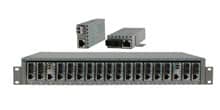- Products
- PoE Media Converters and Switches
- Ethernet & PoE Switches Product Selector
- Multi-Gigabit Ethernet and PoE Switches
- PoE PSE Commercial Switches
- PoE PSE Industrial Fiber Switches
- PoE Industrial Copper Extenders
- PoE Powered Media Converters
- PoE PSE Media Converters
- PoE Extenders & Injectors Product Selector
- Pluggable Transceivers Product Selector
- Product Lines

- iConverter Managed Multi-service Platform
- Copper to Fiber Media Converters
- Ethernet Media Converters
- 10 Gigabit Copper-to-Fiber
- 10/100/1000 Copper to 10 Gigabit Fiber
- 10/100/1000 Copper-to-Fiber with Integrated Management
- 10/100/1000 Industrial Copper-to-Fiber with Integrated Management
- 10/100/1000 Copper-to-Fiber with VLAN
- 10/100/1000 Dual Media Converter with VLAN
- Gigabit Copper-to-Fiber
- 10/100 Copper-to-Fiber with Integrated Management
- 10/100 Industrial Copper-to-Fiber with Integrated Management
- 10/100 Copper-to-Fiber with VLAN
- 10/100 Copper-to-Fiber
- Fast Ethernet Copper-to-Fiber
- Fast Ethernet Redundant Links
- 10Mbps Copper-to-Fiber
- 10Mbps Copper to Coax
- TDM Media Converters
- Serial Media Converters
- Ethernet Media Converters
- Fiber to Fiber Media Converters
- 10 Gigabit Fiber-to-Fiber Converter and Transponder
- 10 Gigabit Industrial Converter and Transponder
- SFP-to-SFP Fiber Converter and Transponder
- SFP-to-SFP Industrial Fiber Converter and Transponder
- Gigabit Fiber to-Fiber with 3 Rs
- 100/1000 Fiber-to-Fiber with 3 Rs
- Gigabit Fiber-to-Fiber
- Fast Ethernet Fiber-to-Fiber with 3 Rs
- Fast Ethernet Fiber-to-Fiber
- OC-3/STM-1 Fiber-to-Fiber
- OC-12/STM-4 Fiber-to-Fiber
- Carrier Ethernet Network Interface Devices
- CE 2.0 - 10G Demarcation NID
- CE 2.0 - 10G Demarcation and Aggregation NID
- CE 2.0 - 10/100/1000 Mult-port NID
- CE 2.0 - 10/100/1000 Mult-port NID with PoE
- CE 2.0 - 10/100/1000 8-Port NID
- SFP NID - Gigabit SFP NID
- microNID - 100/1000 compact NID
- CE 1.0 Service OAM - 10/100/1000 NID
- CE 1.0 Link OAM - 10/100/1000 Copper-to-Fiber NID
- CE 1.0 Link OAM - 10/100 Copper-to-Fiber NID
- CE 1.0 Link OAM - Gigabit Fiber-to-Fiber NID
- CE 1.0 Link OAM - Fast Ethernet Fiber-to-Fiber NID
- CWDM Multiplexers
- T1/E1 Multiplexers
- Ethernet Switch Modules
- Management System
- Chassis Options

- 1-Module Industrial Chassis

- RuggedNet Industrial Switches and Extenders
- Industrial PoE PSE Fiber Switches
- Multi-Gigabit Managed Industrial PoE+/BT Switches
- Multi-Gigabit Unmanaged Industrial PoE+/BT Switches
- 10G Managed 802.3bt PoE Switches
- 10G Unmanaged 802.3bt PoE Switches
- 10G Managed PoE+ Switches
- 10G Unmanaged PoE+ Switches
- 1G Managed PoE+ Switches
- 1G Unmanaged PoE+ Switches
- 1G Unmanaged 802.3bt PoE Switches
- 1G Managed 802.3bt PoE Switches
- Industrial Ethernet Switches
- Industrial PoE Copper Extenders
- Industrial Power Supplies

- OmniConverter Media Converter, Switches and Extenders
- PoE PSE Media Converters
- 10G Multi-Gigabit / Multi-Rate PoE Media Converter
- 10G Multi-Gigabit / Multi-Rate Media Converter
- 10/100 Multi-port PoE+ Media Converter
- 10/100 PoE+ Media Converter
- 10/100/1000 Multi-Port PoE+ Media Converter
- Industrial 10/100/1000 Multi-Port PoE+ Media Converter
- 10/100/1000 PoE+ Media Converter
- 10/100/1000 PoE++ 60W-100W Media Converter
- Industrial 10/100 Multi-port PoE+ Media Converter
- 1U Rack-Mount Shelf
- PoE PSE Compact Switches
- Multi-Gigabit Managed PoE+/BT Switches
- Multi-Gigabit Unmanaged PoE+/BT Switches
- 10G Managed 802.3bt PoE Switches
- 10G Unmanaged 802.3bt PoE Switches
- 10G Managed PoE+ Switches
- 10G Unmanaged PoE+ Switches
- 1G Managed PoE+ Switches
- 1G Unmanaged PoE+ Switches
- 1G Managed 802.3bt PoE Switches
- 1G Unmanaged 802.3bt PoE Switches
- Ethernet Switches
- PoE Copper Extenders
- Single Pair Ethernet Converters
- PoE Injectors

- miConverter Unmanaged Miniature Media Converters
- 10/100/1000 Copper-to-Fiber
- Industrial 10/100/1000 Copper-to-Fiber
- 10/100/1000 Ultra-Compact Copper-to-Fiber
- Gigabit Copper-to-Fiber
- 10/100/1000 Copper-to-Fiber PoE Powered
- 10/100 Copper-to-Fiber
- 10/100 Ultra-Compact Copper-to-Fiber
- 10/100 Copper-to-Fiber PoE Powered
- 18-Module Chassis
- Industrial 10/100 Copper-to-Fiber PoE Powered

- FlexSwitch Compact Switches
- Solutions
- Company
- Support
- How to Buy
Understanding Network Latency and Its Impact on Industrial Applications

In the fast-paced world of industrial automation, split-second decisions can make all the difference. That's where network latency comes in. Network latency measures the time it takes for data to travel across a network from one point to another. While a slight delay might be imperceptible in everyday internet browsing, for industrial applications, even milliseconds of latency can have significant consequences.
Here at Omnitron Systems, we understand the critical role of low-latency networks in industrial settings. In this blog, we'll explore what network latency is, its impact on industrial applications, and strategies for minimizing it.
What is Network Latency?
Imagine sending a control signal from a computer to a robotic arm. Network latency refers to the total time it takes for that signal to travel:
- Processing Time: The time it takes for the sending device to package the data and the receiving device to unpack it.
- Transmission Time: The time it takes for the data to travel physically through the network cables or wireless medium.
- Queuing Time: If the network is congested, data packets may need to wait in a queue before being transmitted, further increasing latency.
Network Latency Impacts on Industrial Applications
Real-time Control Systems
Industrial robots, automated assembly lines, and process control systems rely on real-time communication. High latency can cause delays in receiving sensor data or executing commands, leading to inaccurate movements, malfunctions, and potential safety hazards.
Machine-to-Machine Communication
With the rise of Industrial IoT (IIoT), machines and devices communicate vast amounts of data in real-time. Excessive latency can disrupt these data exchanges, hindering efficient collaboration between machines and impacting overall production.
Remote Monitoring and Diagnostics
Predictive maintenance and remote monitoring often rely on real-time data collection from industrial equipment. High latency can delay the transmission of critical data, hindering early detection of potential issues and leading to unplanned downtime.
Strategies for Minimizing Network Latency
-
Network Segmentation
Create separate segments to isolate critical industrial traffic from non-critical network activities. This reduces congestion and prioritizes real-time industrial data.
-
High-Performance Network Infrastructure
Invest in a network infrastructure designed for low latency. Fiber optic cabling offers superior speed and reduced signal interference compared to copper cabling. Omnitron provides a range of high-performance industrial Ethernet switches optimized for low latency.
-
Network Optimization Techniques
Make use of network optimization strategies such as Quality of Service (QoS) configurations and bandwidth allocation. QoS prioritizes real-time industrial traffic within the network, ensuring it gets transmitted first.
-
Switch Selection
Choose network switches specifically designed for industrial applications. Look for features like low-latency switching hardware which guarantees deterministic data delivery. Omnitron's industrial switches offer these features to minimize latency.
FAQs on Network Latency
How does network latency affect application performance?
Network latency affects application performance by causing delays in data transmission, leading to slower response times. This can be particularly detrimental to real-time applications where timely data delivery is crucial. In industrial settings, high latency can disrupt automated processes and control systems, reducing operational efficiency. Overall, increased latency can lead to a degraded user experience and potential operational issues.
How does network latency impact throughput?
Network latency can limit throughput by increasing the time it takes for data packets to travel across the network. If latency is excessive, the effective data transfer rate can be decreased even with a high bandwidth. This is because each data packet must wait longer for acknowledgment before the next packet can be sent, creating a bottleneck. Consequently, high latency can prevent the network from reaching its maximum throughput potential.
What is the industry standard for latency?
The industry standard for acceptable network latency varies depending on the application. For general internet use, latency below 100 milliseconds (ms) is typically acceptable, while real-time applications like online gaming and VoIP require latency below 50 ms. In industrial applications, particularly those involving real-time control and automation, latency may need to be as low as 1-10 ms. These standards help ensure smooth and efficient operation across different use cases.
What are some other factors that may be affecting latency?
Several factors can affect network latency, including network congestion, where high traffic volumes slow down data transmission. The physical distance between communicating devices also impacts latency, with greater distances causing longer delays. Additionally, the quality and type of transmission media, such as fiber optics versus copper cables, can influence latency. Lastly, the performance of network hardware, including routers and switches, and their processing capabilities can contribute to overall latency.
Omnitron: Your Partner in Low-Latency Networking
By understanding network latency and implementing these strategies, you can ensure your industrial network delivers the speed and reliability your applications require. Omnitron Systems offers a comprehensive range of low-latency networking solutions designed for industrial environments.
Contact Omnitron Systems today to discuss your specific requirements and explore how our solutions can help you minimize network latency and optimize the performance of your industrial applications. Call us now!









